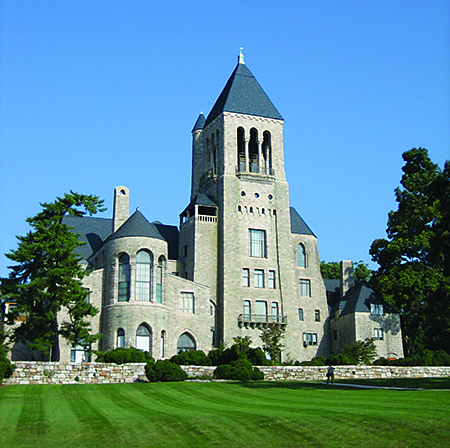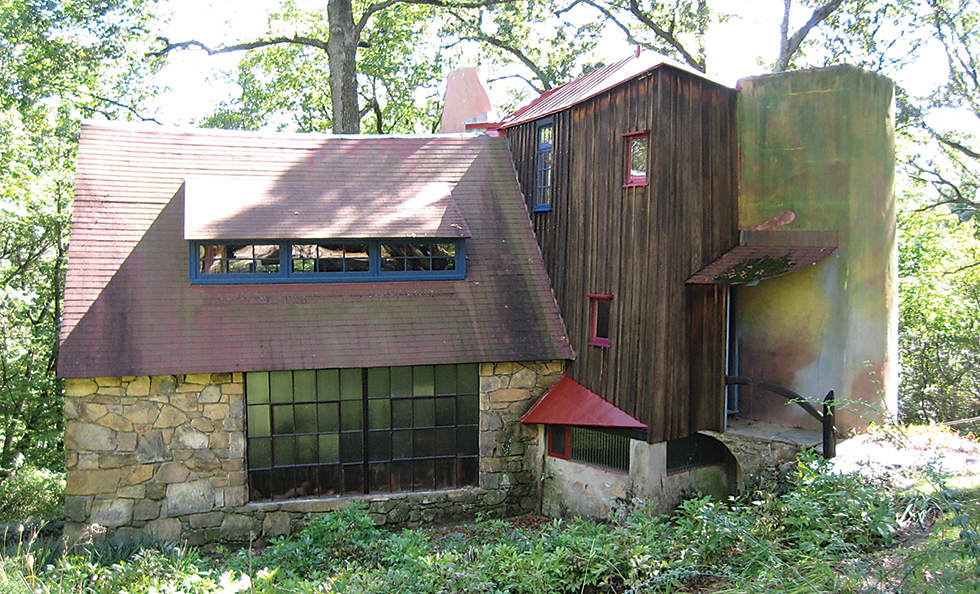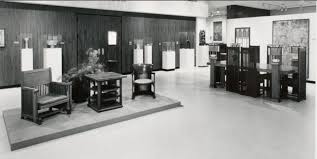ARTS & CRAFTS IN PENNSYLVANIA – Part One
by Anne Mallek ~
I had been to Pennsylvania just over 20 years ago, driving with my family on the Blue Ridge Mountain Parkway from Virginia to Gettysburg and through Amish country, but I had never heard of Fallingwater, and I remained in relative ignorance of the great and very different cities of Pittsburgh and Philadelphia until recently.

The annual Arts and Crafts conference organized by Initiatives in Art and Culture, and held in a different city every year, was this year convened in Philadelphia, based at the Pennsylvania Academy of Fine Arts (PAFA), and entitled “’The Workshop of the World’: The Arts and Crafts Movement in Philadelphia.” For two days in mid-September our group of approximately 100 professionals and enthusiasts were held captive in Frank Furness’s glorious Academy building (1871-76), captivated by 11 lectures from the likes of Richard Guy Wilson (Chair of the Department of Architectural History at the University of Virginia), Julie Sloan (stained glass conservator and scholar, who was also a contributing essayist for A New and Native Beauty: The Art and Craft of Greene & Greene (2008), and Anna Verplanck (former Curator of Prints and Paintings at Winterthur in Delaware).
In Arts and Crafts circles, Philadelphia is perhaps most significant for being the site of the first World’s Fair in the United States. The exhibits and buildings of the Centennial International Exposition of 1876 (celebrating the 100th anniversary of the signing of the Declaration of Independence in Philadelphia) inspired a generation of craftsmen and designers. This included Maria Longworth Nichols (1849-1932), who was so taken with the Japanese displays at the Exposition, that upon her return to Cincinnati she began experimenting with ceramic design and decoration based on Japanese models, culminating in her founding of Rookwood pottery in 1880. In Philadelphia, it gave birth to The Pennsylvania Museum and School of Industrial Art, now the Philadelphia Museum of Art and the University of the Arts. Such schools trained students to design for the large number of local industries, educating them in every aspect of production. PAFA produced a number of talented and influential artists, including Thomas Eakins and Mary Cassatt. As a young architect-in-training, Louis Sullivan worked for Furness while PAFA was being built. PAFA was also where the Red Rose Girls–Violet Oakley, Elizabeth Shippen Green, and Jessie Smith–spent time, eventually meeting as fellow illustrators (Smith designed for the likes of Ladies Home Journal and Good Housekeeping, Green for Harper’s Monthly, and Oakley for various other magazines), and living together for several years at the Red Rose Inn in Villanova, PA. Oakley would eventually become known for her mural paintings (she contributed 43 murals to the Pennsylvania Capitol), while Smith and Green were widely recognized for their children’s book illustrations.
The later nineteenth and early twentieth-century history of Philadelphia is full of such innovators, industrialists and artists alike. Just outside of Philadelphia, one discovers a history equally rich in architecture, art, and craft—from the Quaker architect Will Price’s Rose Valley community, based on principals derived from William Morris’s utopian novel News from Nowhere, to the twentieth-century furniture and hilltop studio/home of Wharton Esherick (about whom we will learn more in our March lecture, “Handcrafted Modern,” by Leslie Williamson), and the eccentric reinforced-concrete-and-tile home of Moravian Pottery founder Henry Chapman Mercer. The conference also included visits to the Swedenborgian Cathedral in Bryn Athyn (1913-28), along with the Gilded Age home of industrialist John Pitcairn, Cairnwood (1892-95), and his son’s nearby Gothic-inspired edifice Glencairn (1928-1939). All are open to the public and beautifully sited, with the Cathedral and Glencairn standing as monuments to the Arts and Crafts ethos of employing local materials and craftsmen, with designers and craftsmen working side by side. John Pitcairn, who also donated the land for the Cathedral, was the founder of Pittsburgh Plate Glass (now PPG Industries), and his brother, Robert, became the head of the Pittsburgh division of Pennsylvania Railroad.
To bring this article full circle—that is, back to Pasadena—Robert Pitcairn’s son (also Robert), hired the Greenes in 1906 to build a home for him on State Street, just off of Orange Grove. The Pitcairn house was one of the earliest to combine all of the elements which we have come to recognize as hallmarks of the Greenes’ (and Halls’) style—the shingled exterior, overhanging eaves and exposed rafters, basement ventilation of green-glazed Chinese tiles, and even the keyed scarf joint. Westridge School for Girls (founded by Mary Ranney in 1913, who designed her own house in the Arroyo Terrace neighborhood while still a draftsperson in the Greenes’ firm) purchased the Pitcairn house in 1963, and is now undertaking the repair and restoration of its exterior. Kelly Sutherlin McLeod and Griswold Conservation Associates, both of whom worked on the Gamble House exterior restoration project in 2003-04, are part of the Pitcairn project team.
Lastly, for those of you who have never been to Philadelphia, I urge you to GO! And don’t forget to visit the surrounding areas—Doylestown (Moravian Pottery and Mercer Museum), Bryn Athyn, Bryn Mawr (where one of C. R. Ashbee’s Guild of Handicraft members, Alec Miller, executed a number of whimsical stone carvings), Valley Forge (Washington Memorial Chapel and the Wharton Esherick Museum), and Rose Valley. You might need to rent a car to gain access to some of these sites, but I promise you it will be worth it! And look out for an email or notice in 2013 about the next Arts and Crafts conference produced by Initiatives in Art and Culture (host city yet to be determined).
Please look for Arts & Crafts in Pennsylvania, part two of this story, in a future blog post. ♦



Leave a Reply